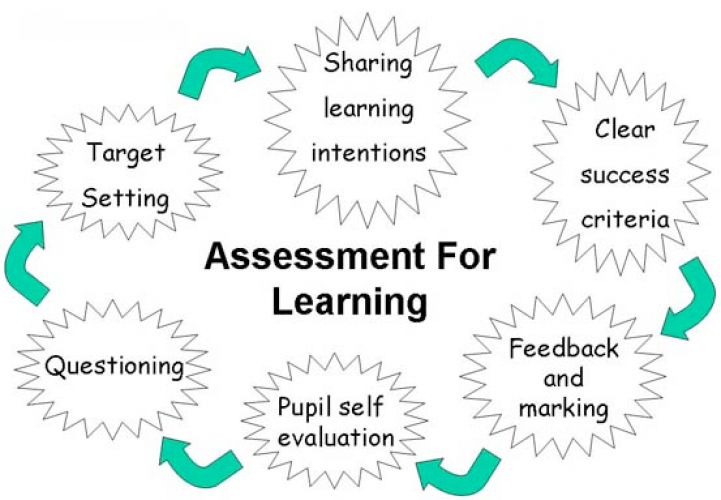ASSESSMENT POLICY
Intended Outcomes
- To gather information on all children which aids/informs/directs planning and future steps in learning
- To identify where additional support or more challenge is needed
- To ensure staff develop good Assessment for Learning (AFL ) practices e.g. scaffolding, modelling, questioning, self/peer assessment, observations
- To ensure staff teach children how to peer and self assess using Steps to Success (S2S), success criteria and pink/green highlighters
- To ensure appropriate differentiation
- To use ongoing, classroom based AfL to ensure learning is challenging and engaging, connected, personalised and meaningful
- For teachers to use AfL to adapt practise immediately, where necessary, to ensure children's needs are catered for
- To gather information which supports the development of specific curricular skills, learning habits and thinking skills
- To use information from questioning, observations, use of S2S, use of success criteria, marking children’s work, pupil interviews and informal ongoing dialogue with pupils
- To work with the children when determining next steps in learning ensuring children have an active role in their own assessment
- To enable children to use metacognitive skills to support the assessment of their learning
Procedures for Assessment in Maths
All staff will:
- Use The Teaching Maths For Understanding (TMU) guidance and the maths Steps to Success (S2S) to help assess conceptual understanding, reasoning, fluency and problem solving
- Ensure children know their next steps in learning by using the TMU guidance, the S2S and learning zones (comfort, stretch and stress)
- Use the TMU guidance to provide a summative review, including next steps, for the child’s next teacher
- Monitor children’s progress and provide evidence (e.g.verbal, annotated S2S, work and plans, samples of work etc) for judgements when appropriate
- Meet with HT formally, twice yearly, to discuss children’s attainment and achievement and informally as necessary
- Annotate the S2S with AfL comments if useful and appropriate
- Expect children to participate in their assessments by adding their own annotations and by discussing which skills are in their comfort zone
- Work with all staff to moderate judgements
- Provide a summative review, including next steps, for the child’s next teacher
- Provide a judgement re: developing/ expected/ greater depth in conceptual understanding, reasoning, problem solving and fluency
Procedures for Assessment in Writing
All staff will:
- Use Steps to Success (S2S) and IOM level descriptors to help assess current achievement and attainment
- Ensure children are aware of their next steps in learning by using the S2S and learning zones (comfort, stretch and stress)
- Use S2S and relevant success criteria to plan for and reflect on children’s writing in individual, group and whole class sessions
- Ensure children have their own S2S to allow them to plan for and reflect on their own and peers’ writing
- Ensure children have time to write both as directed by the teacher and independently on a genre of their own choice
- Use S2S to provide a summative review, including next steps, for the child’s next teacher
- Use the ‘think pink’ and ‘green to go’ highlighting strategy to provide honest, informative feedback on specific writing skills and allow dedicated time to act on this feedback
- Meet with HT formally twice yearly to discuss children’s attainment and achievement and informally as necessary
- Give each child a level based on several samples of independent writing across a variety of genre including writing which the child has done during their own independent learning time - there is no need for formal written assessments
- Provide a summative review, including next steps, for the child’s next teacher
- Work with all staff to moderate judgements
Procedures for Assessment in Reading
All staff will:
- Use the S2S, PM benchmarks, IOM level descriptors to help assess current achievement and attainment
- Ensure all children have opportunities to develop all reading assessment foci using a range of genre in both fiction and non fiction texts
- Annotate S2S with AfL comments for all assessment foci
- Provide a summative review, including next steps, for the child’s next teacher
- Meet with HT formally twice yearly to discuss children’s attainment and achievement and informally as necessary
- Work with all staff to moderate judgements
Procedures for Assessment in Speaking and Listening
- Use the S2S, IOM level descriptors to help assess current achievement and attainment
- Ensure all children have opportunities to develop skills from the S&L descriptors through a range of activities
Procedures for Assessment in Science
- Use the S2S, IOM level descriptors to help assess current achievement and attainment
- Provide a summative review, including next steps, for the child’s next teacher
All areas of learning
- Use the learning zones with the children to help assess their learning and use this information to support future learning
- Set high expectations for all children through the use of assessment procedures that carefully monitor achievement and attainment, involving all children in planning and assessment and ensuring suitable challenge
- Guide children in the use of the learning zones (comfort, stretch and stress) to enable them to have an active role in assessing both their learning habits and curricula/thinking skills in order to both set next steps in learning and reflect on prior learning
EYFS
- Reception children are assessed using the same approaches as above but against the Early learning Goals as they work towards a Good Level of Development
To be read in conjunction with the Teaching for Learning and Feedback policies
Reviewed September 2019, June 2021, July 2022
Next review Sep 2023
